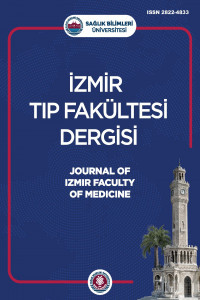Ortopedik Cerrahi Geçiren Geriatrik Hastalarda Postoperatif Kognitif Disfonksiyon ve Serebral Oksimetri Korelasyonu
postoperatif kognitif komplikasyon, geriatrik ortopedik cerrahi, near-infrared spektroskopi, genel anestezi, spinal anestezi
The Correlation of Postoperative Cognitive Dysfunction and Cerebral Oximetry in Geriatric Patients Undergoing Orthopedic Surgery
postoperative cognitif complication, elderly orthopedic surgery, near-infrared spectroscopy, general anesthesia, spinal anesthesia,
___
- 1.Steinmetz J, Christensen KB, Lund T, Lohse N, Rasmussen LS, postoperative cognitive dysfunction (POCD) group. Long-term consequences of postoperative cognitive dysfunction. Anesthesiology. 2009;110:548-55.
- 2.Kotekar N, Shenkar A, Nagaraj R. Postoperative cognitive dysfunction – current preventive strategies. Clin Interv Aging. 2018;13:2267-73. 3.Rasmussen LS, Johnson T, Kuipers HM, Kristensen D, Siersma VD, Vila P et al. Does anaesthesia cause postoperative cognitive dysfunction? A randomised study of regional versus general anaesthesia in 438 elderly patients. Acta Anaesthesiol Scand.2003;47:260-6. 4.Fitzpatrick S, Owen K. Postoperative cognitive disorders : postoperative delirium and postoperative cognitive dysfunction. Anaesth Tutor Week. 2018;152:1-6.
- 5.Chaudhari AP, Mazumdar K, Mehta PD. Anxiety, depression, and quality of life in women with polycystic ovarian syndrome. 2018;40:239-46.
- 6.Figuls RM, Cosp BX, Arevalo-Rodriguez CS. Cochrane database of systematic reviews mini-mental state examination (MMSE) for the detection of Alzheimer’s disease and other dementias in people with mild cognitive impairment (MCI). 2015;5;2015:CD010783.
- 7.Güngen C, Ertan T, Eker E, Yaşar R, Engi̇n F. Mini Mental Test’in Türk toplumunda hafif demans tanısında geçerlik ve güvenilirliği. Türk Psikiyatri Dergisi 2002;13:273-81.
- 8.Myrberg K, Hydén LC, Samuelsson C. The mini-mental state examination (MMSE) from a language perspective: an analysis of test interaction. 2020;34:652-70.
- 9.Owczuk R. Guidelines for general anaesthesia in the elderly of the Committee on Quality and Safety in Anaesthesia, Polish Society of Anaesthesiology and Intensive Therapy. Anaesthesiol Intensive Ther. 2013;45:57-61.
- 10.Elwell CE, Cooper CE. Making light work: Illuminating the future of biomedical optics. Philos Trans R Soc A Math Phys Eng Sci. 2011;369(1955):4358-79.
- 11.Ito H, Kanno I, Iida H, Hatazawa J, Shimosegawa E, Tamura H et al. Arterial fraction of cerebral blood volume in humans measured by positron emission tomography. Ann Nucl Med. 2001;15:111-6.
- 12.Grubhofer G, Plöchl W, Skolka M, Czerny M, Ehrlich M, Lassnigg A. Comparing Doppler ultrasonography and cerebral oximetry as indicators for shunting in carotid endarterectomy. Anesth Analg. 2000;91:1339-44. 13.Tang L, Kazan R, Taddei R, Zaouter C, Cyr S, Hemmerling TM. Reduced cerebral oxygen saturation during thoracic surgery predicts early Postoperative cognitive dysfunction. Br J Anaesth. 2012;108:623-9.
- 14.Çelik EC, Çiftçi B. Cerebral oximetry and applications under anesthesia. İstanbul Tıp Fakültesi Derg. 2018;8:33-6.
- 15.Slater JP, Guarino T, Stack J, Vinod K, Bustami RT, Brown JM 3rd et al. Cerebral oxygen desaturation predicts cognitive decline and longer hospital stay after cardiac surgery. Ann Thorac Surg. 2009;87:36-45. 16.Hoppenstein D, Zohar E, Ramaty E, Shabat S, Fredman B. The effects of general vs spinal anesthesia on frontal cerebral oxygen saturation in geriatric patients undergoing emergency surgical fixation of the neck of femur. J Clin Anesth. 2005;17:431-8. 17.Mandal S, Basu M, Kirtania J, Sarbapalli D, Pal R, Kar S et al. Impact of general versus epidural anesthesia on early post-operative cognitive dysfunction following hip and knee surgery. J Emergencies, Trauma Shock. 2011;4:23-8.
- 18.Shi HJ, Xue XH, Wang YL, Zhang WS, Wang ZS, Yu AL. Effects of different anesthesia methods on cognitive dysfunction after hip replacement operationin elder patients. Int J Clin Exp Med. 2015;8:3883-8.
- 19.Papadopoulos G, Karanikolas M, Liarmakopoulou A, Papathanakos G, Korre M, Beris A. Cerebral oximetry and cognitive dysfunction in elderly patients undergoing surgery for hip fractures: a prospective observational study. Open Orthop J. 2012;6:400-5.
- 20.Kim J, Shim JK, Song JW, Kim EK, Kwak YL. Postoperative cognitive dysfunction and the change of regional cerebral oxygen saturation in elderly patients undergoing spinal surgery. Anesth Analg. 2016;123:436-44.
- 21.Colak Z, Borojevic M, Bogovic A, Ivancan V, Biocina B. In fl uence of intraoperative cerebral oximetry monitoring on neurocognitive function after coronary artery bypass surgery : a randomized, prospective study. 2015;47:447-54.
- Başlangıç: 2022
- Yayıncı: Sağlık Bilimleri Üniversitesi
Çözünür Epoksit Hidrolaz Geni ve Bu Genle İlgili Hastalıkların Derlenmesi
Kamil DURAN, Derya Deniz KANAN
Subksifoid Uniportal Cerrah Destekli Robotik Akciğer Lobektomisi: Olgu Sunumu
Ayşegül ÇİFTÇİ, Celal Buğra SEZEN, Gamze TANRIKULU, Muzaffer METİN
İmmunsupresif Tedavi Alan Hastalarda Hepatit B Reaktivasyonu Riskinin Değerlendirilmesi
Mehmet CEYLAN, Melda TURKEN, Sarp SİNGİL, Pelin ADAR, Şükran KÖSE
Gece ve Gündüz Başvuruya Göre Akut Apandisit
Orhan ÜREYEN, Abidin Gazi ALAGÖZ, Murat Can KALE, İlhan DURSUN, Emrehan İNCİ, Enver İLHAN
Videotorakoskopik Yardımlı Torasik Cerrahi İle Superior Sulcus Tümör Rezeksiyonu: Olgu Sunumu
Oğuzhan BAYRAKTAR, Celal Buğra SEZEN, Özkan SAYDAM, Muzaffer METİN
COVİD-19 Pandemisinin Ani İşitme Kaybı ve Tedavi Seçimlerine Etkisi
Serdar SAĞSÖZLÜ, Ertuğrul YAVUZ
COVID-19 Obez Çocuklarda Daha Ağır mı Seyrediyor?
Aslıhan ARSLAN MADEN, Yıldız EKEMEN KELEŞ, Eda KARADAG-ONCEL, Gülnihan ÜSTÜNDAĞ, Aslıhan ŞAHİN, Ayşegül ELVAN TÜZ, Selin TAŞAR, Hayrullah MANYAS, Ahu KARA AKSAY, Dilek YILMAZ ÇİFTDOĞAN, Bumin DÜNDAR
İnflamatuvar Fibroid Polipler ve Platelet Türevli Büyüme Faktörü Reseptör Mutasyon Analizi
Nuket ÖZKAVRUK ELİYATKIN, Özen Özden YÜKSELEN, Seda KARAOĞLU BAYTEKİN, Yasemin BAŞBINAR, Altay KANDEMİR
Yara Polikliniğine Başvuran Hastaların Yara Takip Sonuçlarının Değerlendirilmesi
Alper ERKİN, Ayşe ÇELİK YILMAZ, Hande CENGİZ AÇIL, Özge YAMAN, Aysel GÜL, Dilek AYGİN
